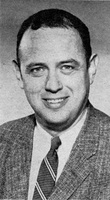 | Back to e-WV
| Back to e-WV
 The West Virginia Encyclopedia
The West Virginia Encyclopedia
 | Back to e-WV
| Back to e-WV
 The West Virginia Encyclopedia
The West Virginia Encyclopedia

The campaign to have coal miner’s pneumoconiosis (black lung) proclaimed a compensatory injury galvanized the West Virginia coalfields in the late 1960s.
As coal mining expanded, more workers exhibited symptoms of ‘‘miner’s asthma,’’ as the disease was originally called. The higher levels of coal dust produced by 20th-century mine mechanization increased the frequency of the disease. Still, black lung went officially unacknowledged. Three studies by the U.S. Public Health Service between 1924 and 1945 failed to bring recognition of black lung as a debilitating condition. Even though Great Britain recognized coal-related pneumoconiosis as a compensatory injury in 1943, American mainstream medical opinion contended that miner’s asthma reflected a normal condition of mine work and actually posed no serious problems. Some doctors pointed out that the disease failed to appear on x-rays, and some suggested that complaining workers were trying to obtain illegitimate compensation. More sympathetic doctors worked to establish reliable means of diagnosis.
From 1942 to 1968, miners at their union’s national convention consistently requested that the United Mine Workers of America undertake the task of having black lung declared a compensable disease. An authoritarian union leadership ignored or sidetracked such demands until 1968, when UMWA President Tony Boyle supported a campaign for black lung recognition at the state level only. In November 1968, an explosion at Consolidation Coal’s No. 9 mine at Farmington, Marion County, killed 78 miners, and a national television audience heard political officials and the UMWA president defend the company, even suggesting that disasters constituted an accepted risk in mining. Occurring within an era of social unrest, Farmington contributed to the growing belief that an entrenched system needed reform from below.
Miners in Fayette County enlisted the aid of physicians I. E. Buff and Donald Rasmussen to educate workers about the disease. In a series of local meetings, Buff encouraged miners to take matters into their own hands. Poverty War volunteers such as Craig Robinson, familiar with civil protest, joined in the call for grassroots action, and in December 1968 a small group of miners in Montgomery formed the Black Lung Association. The new association hired liberal attorney Paul Kaufman to supervise the drafting of a compensation bill and lobby it through the state legislature.
Support spread through the coalfields while the legislature met in early 1969. Black lung activists from across the state assembled at the Charleston Civic Center on January 26 where Congressman Ken Hechler and state legislator Warren McGraw joined Rasmussen, Buff, and Dr. Hawey A. Wells Jr. to encourage the gathering to act decisively. On February 18, 282 miners at a Raleigh County mine went on strike over the black lung issue, and within a few days the walkout spread throughout southern West Virginia. On February 26, 2,000 miners protesting at the capitol heard Governor Moore promise a new bill for a special session of the legislature. Ignoring Moore’s offer, the protesters moved into the capitol to lobby for themselves. The House judiciary committee reported out a weak version of the bill and, in reaction, all the state’s coal miners, over 40,000, stopped work. Under pressure from hundreds of coal miners at the capitol, the House and then the Senate passed a stronger bill.
Events in West Virginia made black lung a national issue as Congress engaged in producing the sweeping Coal Mine Health and Safety Act of 1969. The new law placed strict standards on respirable dust levels and provided federally financed compensation for miners disabled by black lung and the widows of anyone who had succumbed to the disease. More liberal eligibility regulations increased the unexpectedly high cost of the black lung program in 1972, approaching $1 billion per year. The implementation of a tonnage tax on coal was meant to reduce the burden on taxpayers, but evidence suggests that the federal treasury bore the major cost into the 1980s. The Reagan administration implemented stricter eligibility standards for new claimants in 1982, ending the presumption that any miner with 15 years’ experience qualified regardless of x-ray evidence.
In the early 21st century, about 80,000 American miners and family members received about $460 million in annual benefits. By 2023, the number of beneficiaries nationally had fallen to 27,572, and the total in annual benefits was approximately $149 million.
In 2022, the federal Inflation Reduction Act reinstated and made permanent a tax on coal to fund the Black Lung Disability Trust Fund. Previously, Congress had periodically extended the tax on a temporary basis and had allowed it to lapse on occasion.
Written by Paul H. Rakes
Smith, Barbara E. Digging our Own Graves: Coal Miners and the Struggle over Black Lung Disease. Philadelphia: Temple University Press, 1987.
Hume, Brit. Death in the Mines: Rebellion and Murder in the United Mine Workers. New York: Grossman Pub., 1971.
Seltzer, Curtis. Fire in the Hole: Miners and Managers in the American Coal Industry. Lexington: University Press of Kentucky, 1985.